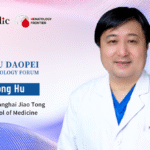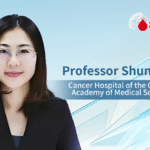
On August 22–23, 2025, the 13th Lu Daopei Hematology Conference was held in Beijing, jointly organized by the Beijing Health Promotion Association and the Guangzhou Kapok Oncology and Rare Disease Foundation, and hosted by the Beijing Lu Daopei Hematology Institute. The conference gathered world-leading hematology experts and focused on hematopoietic stem cell transplantation, cellular therapy, and precision treatment of hematologic malignancies. With over a thousand participants, the meeting provided a high-level and in-depth academic exchange. During the conference, Professor Fang Liu from Shanghai Xindaobei Hematology Hospital delivered a presentation on the latest clinical advances of CAR-T therapy in acute myeloid leukemia (AML). Oncology Frontier – Hematology News invited Professor Liu to elaborate on the core clinical issues, offering important insights to guide optimized management strategies. PART 1
AML continues to have a poor prognosis, especially in relapsed or refractory (r/r) cases. From a clinical perspective, what are the major challenges of CAR-T therapy in AML compared with acute lymphoblastic leukemia (ALL)? Could you also address any unique challenges for Chinese AML patients?
Professor Fang Liu: The development of CAR-T cell therapy has advanced rapidly, and its application in lymphoid leukemias and plasma cell malignancies is relatively well established. However, in AML, clinical use of CAR-T remains exploratory. Compared with lymphoid malignancies, AML presents several unique challenges.
The first issue is antigen selection. An ideal CAR-T target should be expressed uniformly across tumor cells and have minimal off-tumor toxicity. In AML, both criteria are difficult to achieve. Current candidate targets, including CD33, CD123, CLL-1, FLT3, as well as lineage-crossing antigens like CD19 and CD7, all show high heterogeneity—not all patients express them, and in some patients expression is absent altogether. Moreover, antigen loss or shift during treatment further undermines therapeutic efficacy.
Second, AML poses distinct efficacy challenges. The myeloid tumor microenvironment often contains strong immunosuppressive factors that inhibit CAR-T cell expansion in vivo, leading to weaker antitumor activity compared with their performance in lymphoid malignancies.
Third, toxicity management is a major barrier. In AML, CAR-T therapy inevitably damages normal hematopoietic cells, causing profound and prolonged bone marrow suppression. Patients thus face risks of marrow failure, life-threatening infections, and bleeding. Severe infections during therapy can even become fatal.
In summary, limited target options, reduced efficacy, and difficult toxicity management remain the main reasons why CAR-T therapy in AML has not yet achieved the same maturity as in lymphoid and plasma cell malignancies.

PART 2
Could you highlight the most promising or breakthrough advances in CAR-T therapy for AML in recent years? Specifically, what progress has been made with new targets or novel CAR designs, and what encouraging clinical results have been achieved? How does CAR-T currently perform in terms of remission rates and durability in AML?
Professor Fang Liu: Clinical research into CAR-T for AML is ongoing. As early as 2017, a team from City of Hope in the United States reported CD123-targeted CAR-T trials at the ASH Annual Meeting. The results were disappointing—only a few patients achieved complete remission, and the trial was halted by the U.S. FDA due to CD123-related off-target toxicity, such as vascular leak syndrome. Similarly, trials targeting CD33, including studies led by Professor Weidong Han’s team at the General Hospital of the People’s Liberation Army and work at the First Affiliated Hospital of Soochow University, showed limited efficacy with only short-lived responses.
In recent years, domestic and international groups have been exploring new targets. These include dual-target CAR-T therapies such as CD33/CLL-1, single-target CLL-1 CAR-T, FLT3-targeted CAR-T, and lineage-crossing targets like CD19 and CD7. Our own team participated in CD33/CLL-1 dual-target CAR-T research, which demonstrated relatively high remission rates. At the ASH Annual Meeting, President Peihua Lu of Daopei Hospital presented CD7-targeted CAR-T therapy in AML, achieving remission rates above 70%. In addition, Professor Mingfeng Zhao’s group from Tianjin First Central Hospital reported a large-cohort study of CLL-1 CAR-T, also with remission rates exceeding 70%. These findings mark significant breakthroughs in the field of AML CAR-T therapy.
Nevertheless, important challenges remain. The expression rates of these targets are limited: CD7 positivity is found in only about 20%–30% of AML patients, while CLL-1 expression occurs in 50%–80%. As a result, many patients do not qualify for enrollment in these studies. Continued efforts are needed to discover novel targets, refine strategies, and expand clinical trials. For example, although the CD33/CLL-1 dual-target CAR-T program has been temporarily paused, its preliminary results suggest that broader antigen coverage may lead to improved efficacy. Larger patient cohorts will be necessary to confirm its clinical value.
PART 3
Some studies suggest that CAR-T therapy alone in AML leads to only short remissions, while subsequent bridging transplantation can prolong survival. How do you view this strategy? In your clinical practice, which AML patients are suitable for CAR-T combined with transplantation, and how should the timing of transplantation be managed?
Professor Fang Liu: The clinical application of CAR-T in acute myeloid leukemia is markedly different from its use in lymphoid malignancies, as it is difficult to establish CAR-T as a stand-alone therapeutic option in AML. First, as mentioned earlier, its efficacy in terms of remission duration remains insufficient. Second, CAR-T treatment causes profound myelosuppression. Because AML-related targets are often also expressed on normal hematopoietic stem cells, CAR-T therapy not only attacks tumor cells but also inevitably eradicates normal hematopoiesis, leading to sustained marrow dysfunction. As long as CAR-T cells persist in vivo, hematopoietic recovery is compromised; yet once hematopoiesis recovers, it often signals CAR-T exhaustion, which in turn may result in relapse.
This therapeutic paradox is currently addressed primarily through bridging to allogeneic hematopoietic stem cell transplantation (allo-HSCT) following CAR-T treatment. To date, no studies have demonstrated that AML patients can achieve long-term disease control with CAR-T therapy alone. Consequently, most research centers now combine CAR-T therapy with allo-HSCT, in some cases even positioning CAR-T as part of the conditioning strategy. In this context, CAR-T serves to eradicate both tumor cells and hematopoietic stem cells, thereby preparing the patient for transplantation.
In conclusion, AML patients eligible for transplantation should, whenever possible, receive CAR-T therapy in combination with allo-HSCT. The recommended approach is to initiate CAR-T once all preparatory steps for transplantation are completed, and then proceed rapidly to transplantation after achieving remission. This strategy minimizes the duration of neutropenia and marrow aplasia, thereby reducing the risks of complications and mortality.

Expert Profile

Professor Fang Liu Shanghai Xindaobei Hematology Hospital
Professor Liu earned her medical degree at Xiangya School of Medicine, her master’s degree at Peking Union Medical College, and her doctorate at Peking University Health Science Center. She subsequently completed postdoctoral research at the Nevada Cancer Institute in the United States.
She currently serves as Deputy Medical Director of Shanghai Xindaobei Hematology Hospital and Director of the First Department of Hematology. In 2016, she trained in CAR-T cell culture techniques at iCellgene in the U.S.
With nearly 20 years of experience in hematopoietic stem cell transplantation, Professor Liu has independently led close to 800 transplants, the majority of which were haploidentical procedures. She has developed an integrated transplant management system and has extensive expertise in relapse prevention and complication management.
She has also led multiple clinical trials of CAR-T therapy. Notably, she performed the world’s first dual-target CLL1-CD33 CAR-T therapy in relapsed/refractory AML, as well as the world’s first BCMA-CD19 dual-target CAR-T therapy in autoimmune disease. Her team’s work has been presented at major international conferences, including EHA 2018, ASH 2018, iwCAR 2019, ASH 2019, EHA 2020, and iwAL 2022. Her research was recognized as the Best Abstract at EHA 2018 and included in the Best of EHA in the leukemia section in 2020.


